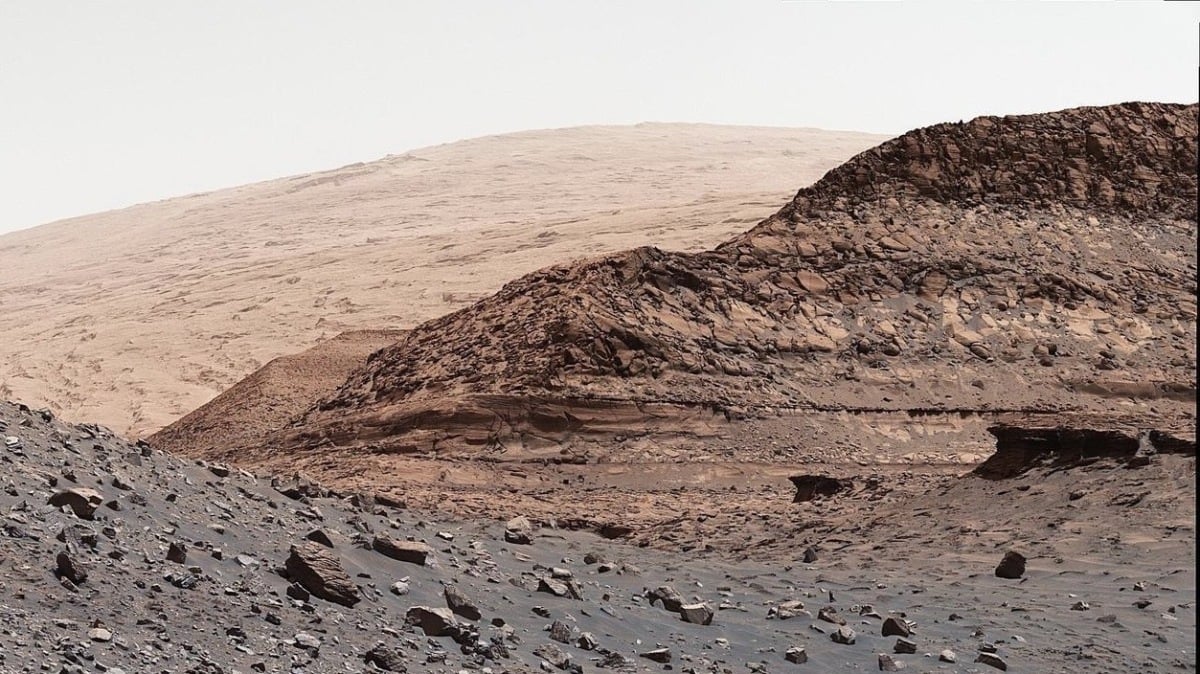
A remarkable NASA rover operating on Mars has made a groundbreaking discovery by uncovering a significant mineral that remained undetected by orbiters closely monitoring the Red Planet from space. This revelation opens new avenues for understanding the planet’s geological history.
Scientists claim that the identification of siderite, a form of iron carbonate, could provide pivotal evidence supporting the hypothesis that Mars once possessed a thick atmosphere rich in carbon dioxide. This atmospheric condition may have created a warm enough environment to sustain oceans, lakes, and flowing streams on its surface.
The Curiosity rover, a car-sized mobile laboratory equipped with advanced tools, conducted a thorough chemical analysis of four rock samples extracted from various elevations on Mount Sharp. This mountain is located within the expansive Gale Crater, which has been the rover’s exploration site. Of the four samples analyzed, three contained substantial amounts of siderite. The remaining sample, devoid of significant siderite, included other iron-rich minerals that typically form during the decomposition of siderite.
This iron carbonate mineral is recognized for its formation on Earth under specific chemical conditions that involve the presence of water, iron, and carbon dioxide. The recent study, which has been published in the journal Science, indicates that more carbon may be stored within the Martian crust than previously estimated. If similar carbonates can be found in other sulfate-rich regions, they could represent a hidden reservoir of Mars’ ancient atmosphere.
According to Benjamin Tutolo, the lead author of the study, “The discovery of abundant siderite in Gale Crater signifies both a surprising and crucial advancement in our comprehension of the geologic and atmospheric evolution of Mars,” he stated in an official announcement.
These scientists think alien life best explains what Webb just found
NASA’s Curiosity rover captures a stunning selfie on lower Mount Sharp within Gale Crater in August 2015.
Credit: NASA / JPL-Caltech / MSSS
The findings further substantiate the growing body of evidence suggesting that ancient Mars possessed the ideal chemical and environmental conditions necessary for liquid water to exist, alongside the ability to trap and cycle carbon in its atmosphere. These factors are critical in evaluating the planet’s past habitability.
Mashable Light Speed
For many years, scientists have espoused the theory that Mars used to have surface water. However, for this to be plausible, the planet would have needed to maintain a warmer climate with elevated air pressure. This reasoning has led researchers to postulate that although Mars’ atmosphere is exceedingly thin today, it must have been significantly thicker and rich in carbon dioxide in its geological past.
It is believed that volcanoes could have emitted large quantities of carbon dioxide into the Martian atmosphere. Over time, although some of this gas might have escaped into space, a substantial portion likely remained, enabling the existence of lakes and rivers across the Martian landscape.
Throughout the last thirty years, numerous pieces of evidence have emerged that indicate water flowed on ancient Mars. Yet, until now, there has been a missing component linking the atmosphere to the geological record: carbon dioxide in both air and water would have reacted with rocks, resulting in the formation of various carbonate minerals. This raises the question: where are these minerals?

At a Martian site dubbed Ubajara, NASA’s Curiosity rover unveils the presence of siderite, an iron carbonate mineral that may solve the mystery surrounding the planet’s atmospheric deterioration.
Credit: NASA / JPL-Caltech / MSSS
After drilling less than 2 inches into the Martian surface, Curiosity utilized its CheMin instrument to carry out X-ray diffraction analyses on the rock and soil samples, as detailed in the new publication. The detection of siderite indicates that the rocks likely formed in tranquil water environments, such as lakebeds, rather than originating from volcanic activity or lava flows. On Earth, siderite typically forms in shallow lakes and wetlands.
In addition, Curiosity identified the presence of sulfates, minerals that are known to form when water evaporates. Geologists extract valuable insights about a planet’s history from the sequence in which minerals are deposited. The finding that siderite formed first in this sequence suggests a progressive drying of ancient Martian lakes, which left behind other mineral deposits. The sample that lacked siderite but contained evidence of its decomposition supports the idea that Mars’ carbon cycle was once robust but has since become unbalanced over time.
Thomas Bristow, a NASA research scientist and co-author of the study, remarked, “Drilling through the layered Martian surface is akin to flipping through a history book. Just a few centimeters below the surface reveals a wealth of information about the minerals that formed at or near the surface approximately 3.5 billion years ago.”
If similar carbonates are discovered in other sulfate-rich layers throughout Mars, they could potentially contain vast amounts of carbon—possibly equal to or even exceeding the current levels of carbon dioxide found in Mars’ atmosphere. Future observations and explorations could validate these findings and enhance our understanding of how the planet evolved as it lost its once-thicker atmosphere.
var facebookPixelLoaded = false;
window.addEventListener(‘load’, function(){
document.addEventListener(‘scroll’, facebookPixelScript);
document.addEventListener(‘mousemove’, facebookPixelScript);
})
function facebookPixelScript() {
if (!facebookPixelLoaded) {
facebookPixelLoaded = true;
document.removeEventListener(‘scroll’, facebookPixelScript);
document.removeEventListener(‘mousemove’, facebookPixelScript);
!function(f,b,e,v,n,t,s){if(f.fbq)return;n=f.fbq=function(){n.callMethod?
n.callMethod.apply(n,arguments):n.queue.push(arguments)};if(!f._fbq)f._fbq=n;
n.push=n;n.loaded=!0;n.version=’2.0′;n.queue=[];t=b.createElement(e);t.async=!0;
t.src=v;s=b.getElementsByTagName(e)[0];s.parentNode.insertBefore(t,s)}(window,
document,’script’,’//connect.facebook.net/en_US/fbevents.js’);
fbq(‘init’, ‘1453039084979896’);
fbq(‘track’, “PageView”);
}
}










